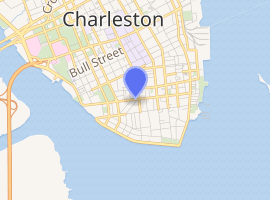Charleston Theatre
Charleston Theatre, also called Broad Street Theatre was a theatre in Charleston, South Carolina between 1794 and 1833.[1] It was the first permanent theatre in Charleston, the first with a permanent staff, and the only theater for much of its duration. It was succeeded by the New Charleston Theatre (1837–1861).[2]

| |
| Address | Charleston, South Carolina United States |
|---|---|
| Coordinates | 32°46′32.89″N 79°56′11.21″W |
| Construction | |
| Opened | 1794 |
| Demolished | 1833 |
History
Since the first temporary theatre Dock Street Theatre in 1736, several playhouses had been constructed in Charleston to house the Old American Company during their visits in the city, the last of whom, Church Street Theatre, built in 1773 to replace the 'New Theatre' of 1754, burnt down in 1782. Charleston was the center of a Planter Aristocracy who spent half the year in the city living a society life in which theater was considered a suitable part, and a new theater house was therefore regarded necessary after the repeal of the Vagrancy Act of 1787, which had the effect of banning the theater.[3]
Charleston Theatre initially housed the Company of Thomas Wade West, which was called Charleston Company or South Carolina Company when performing there, and Virginia Company when performing in Virginia. Until 1817, the St. Cecilia Society performed their concerts in the building, as well as participating in the theatre orchestra.[4]
In 1794, John Sollée opened the Charleston French Theatre or Théâtre Francais, which became a powerful rival, able to offer artists from Saint Domingue such as Alexander Placide and Suzanne Douvillier. In 1796, Thomas Wade West sold the Charleston Theatre to John Sollée, uniting the two theatres. Under Placide, the theater was the base of the Charleston Company, which also performed in Savannah in Georgia (from 1801) and Richmond, Virginia (from 1804) until 1812. It was closed during the war of 1812 but reopened in 1815.
In 1817, the theater was the center of the Charleston Theatre riot, in which the audience sided with the popular star actor James H. Caldwell during his conflict with the management.
The theatre deteriorated during the 1820s and went bankrupt in 1833.
- Managers
- 1793-1796: Thomas Wade West
- 1796-1799: John Sollée
- 1799-1812: Alexander Placide
- 1812-1813: Charlotte Wrighten Placide
- 1813-1815: The theater is closed.
- 1815-1817: Joseph George Holman
- 1817-1822: Charles Gilfert
- 1822-1825: Amelia Holman Gilfert
References
- Robin O. Warren, Women on Southern Stages, 1800-1865: Performance, Gender and Identity
- Charles S. Watson: The History of Southern Drama
- Curtis, Julia (March 1971). "The Architecture and Appearance of the Charleston Theatre: 1793-1833". Educational Theatre Journal. The Johns Hopkins University Press. 23 (1): 1–12. doi:10.2307/3205439. JSTOR 3205439.
- Butler, Nicholas Michael. Votaries of Apollo: The St. Cecilia Society and the Patronage of Concert Music in Charleston, South Carolina, 1766–1820. Columbia: University of South Carolina Press, 2007.